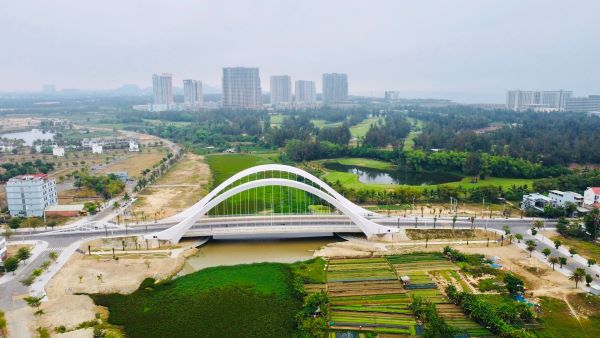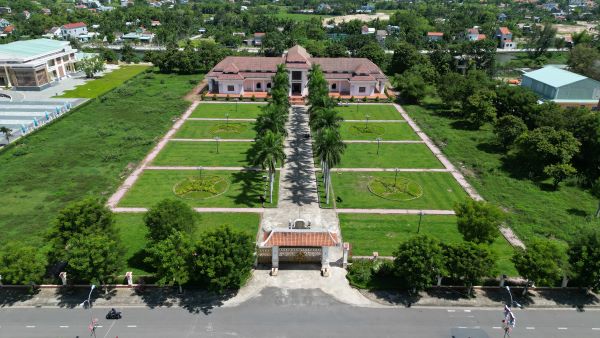On the cultural and lifestyle level, highlights also represent the distinctive values and living styles of the urban residents, showcasing the unique characteristics of each region.
Highlights often feature unique designs that distinguish them from their surroundings, such as height, color or shape. They carry cultural, historical or symbolic meanings, inspiring a sense of pride and emotional connection for the community, while also contributing to aesthetic value. Highlights serve as landmarks, helping locals and visitors easily recognize and navigate the urban space.
Ha Noi's highlights include the 36 Streets area with its ancient architecture and vibrant narrow alleys. Hoan Kiem Lake and the Turtle Tower, symbols of the capital, are closely linked to the legend of King Le Loi returning the sacred sword. The Temple of Literature – Quoc Tu Giam, Vietnam's first university, honors the nation's tradition of valuing education. The Ho Chi Minh Mausoleum, an important historical site, is the resting place of the beloved leader. Hanoi Pho and Bun Cha Ca La Vong... offer distinct and refined flavors.
Ben Thanh Market is a symbol of Ho Chi Minh City, where tradition and modernity intersect, attracting both domestic and international visitors. Notre-Dame Cathedral and the Central Post Office, famous French colonial architectural works, exude ancient and unique beauty. Nguyen Hue Walking Street, a modern entertainment hub, is lively at night. The Independence Palace, associated with the historic event of Vietnam's reunification in 1975, stands as a significant landmark. Saigon Pho, Com Tam (broken rice), and Hu Tieu Nam Vang... showcase the city's liberal and diverse culinary style.

Da Nang's highlights include the Dragon Bridge, which blends modern elements with traditional culture. Ba Na Hills, a mountain resort with a cool climate, features the famous Golden Bridge and architecture in European style. My Khe Beach, one of the most beautiful beaches in Vietnam, is another prominent attraction. The Marble Mountains (Ngũ Hành Sơn) and Bai But Pagoda are renowned spiritual tourism destinations.
Hoi An Ancient Town, a UNESCO World Heritage site, is known for its ancient houses, vibrant lanterns, and nostalgic atmosphere. The Japanese Bridge (Chùa Cầu), a unique architectural landmark, is a symbol of Hoi An. The Hoai River offers a romantic landscape, especially enchanting during lantern festivals at night. Thanh Ha Pottery Village and Tra Que Vegetable Village are where visitors can experience traditional crafts and local culture. My Quang, pork wrapped in rice paper, and Cao Lau Hoi An are local delicacies that carry the distinct flavors of this heritage-rich region.
The highlights of Hanoi, Ho Chi Minh City, Da Nang, and Hoi An always leave a strong impression on anyone who visits. So, what are the highlights of Dien Ban Urban Area? Answering this question is not an easy task. Dien Ban is a land of "fertile soil and talented people"(“địa linh, nhân kiệt”) but if we do not start defining, shaping, designing, and preserving it now, it will be difficult to create a unique urban area with distinct highlights.
According to Quang Nam Provincial Planning approved by the Government and the Adjustment of the Dien Ban Urban Master Plan approved by the Provincial People's Committee, Dien Ban will become a type III urban area before 2030. The nature and function of Dien Ban Urban Area is the dynamic central urban area of the north of Quang Nam Province, connecting with the Central Coastal Ecotourism Center with Da Nang City and the Hoi An ancient urban area.
From the above orientation, it is necessary to create a breakthrough in service development, especially tourism in Dien Ban town. In parallel with the promotion and investment calling work, it is necessary to create some highlights on the cultural foundation and people of Quang Nam, so that Dien Ban highlights become the soul of the urban area, an attractive destination, holding tourists' feet.
Thanh Chiem Palace Park and the National Language Stele are a special highlight of Dien Ban Urban Area. This place was considered the second capital in Dang Trong under the Nguyen Lords (Chúa Nguyễn); a place to practice and train princes, a place to implement open-door policies and people-friendly policies. In terms of military, it used to be a powerful naval base, a place to establish a solid logistics base that played an important role in the expansion to the South in the 17th - 18th centuries. Thanh Chiem Palace, the largest administrative center of Quang Nam town (Trấn Quảng Nam), was the place where Catholicism was introduced earliest in Dang Trong. The Hoi An - Thanh Chiem area was also the cradle of the formation of the National Language in the first half of the 17th century. The Palace Park and the National Language Stele have special cultural and historical values. On the north-south journey, the completed Palace Park (Công viên Dinh Trấn) will be an ideal stop for many domestic and foreign tourists to witness the birthplace of the National Language, opening New Learning period of country's education.
In addition, Phuoc Kieu bronze casting village, fine art carpentry village, Dong Khuong pottery village, Phu Chiem Quang noodles (Mỳ Quảng Phú Chiêm), Cau Mong roasted veal (Bê thui Cầu Mống), unique culinary specialties of Quang Region will enrich for Quang Nam heritage journey tour.
The highlight of Dien Ban-Hoi An coastal urban area is Co Co River with landscape bridges connecting east-west traffic and leading to the sea. Investing in the construction of urban projects along the Co Co River must be model urban projects with green living spaces, meeting the needs of residents and tourists. The Co Co River, which is being dredged, is a tourist river connecting Da Nang with Hoi An, the soul, the "Dragon vein" (Long Mạch) of Quang Nam-Da Nang. Therefore, the bridges connecting the two banks must be landscape bridges, a highlight for the tourist river. The Thon 3 Bridge in Dien Ngoc Ward has just been completed, built according to an architectural design with the image of a crane flapping its wings and reaching out to the vast East Sea. This is the second prize winning design in the architectural competition for bridges across the Co Co River organized by the town.

In 2025-2030 period, Dien Ngoc-Dien Duong coastal population will be arranged to form a Sea Square, a necessary highlight on the coastal tourist route of Da Nang-Hoi An. The Sea Square will be the space for the fishing festival, a venue for performances of Bai Choi singing, folk songs, Ho Khoan and Ba Trao, a type of folk performing art imbued with rituals of the Central coastal region's residents.
On National Highway 1A adjacent to Da Nang city, Me Thu park (phase 2), a community digital library is being built. This is also a cultural highlight in the digital transformation phase, contributing to the construction of a smart city. The community digital library aims to be a space for communication and reading books through online forms combined with paper books, helping people easily access knowledge with pre-equipped electronic devices, contributing to the development of reading culture and lifelong learning movement. The community digital library is designed according to green standards, a place to organize cultural and artistic exchange activities; exchange authors - works; inspire and spread reading culture to the community.
Bang An Tower is also a highlight of Dien Ban urban area. According to researchers, the tower was built around the end of the 9th century to the beginning of the 10th century for the purpose of worship and sacrifice. Inside the tower worships Shiva, the supreme god of the Cham people. Compared to other Cham towers, Bang An Tower has a unique architecture. This is the only octagonal tower remaining to this day in Vietnam. Bang An Tower is considered one of the largest brick sculptures of the once brilliant Champa culture...

Dien Ban Museum and Famous people's statues garden located in the Quang Nam provincial citadel (Thành tỉnh Quảng Nam), a provincial cultural relic, is also a highlight that not every urban area has. Dien Ban Museum is needed to be expanded to have enough space to accommodate and display artifacts from the Sa Huynh culture, Cham culture, or artifacts from the period of national liberation struggle, homeland construction and ancient lamps donated by the homeland's children... with a more modern and vivid display method to create interaction, experience, and attract visitors. In front of the Museum is Famous people's statues garden, which depicts a number of typical famous people with strong cultural identity of Quang Nam, such as the spirit of studiousness, patriotic tradition, revolutionary heroism, diligence, overcoming difficulties, intelligence... Paying tribute to and honoring famous people is to arouse aspirations, self-reliance, inspire future generations, create an endogenous source of strength to contribute to promoting the development of Dien Ban homeland.
Highlight is the city's soul and it will the impression left in the hearts of tourists. The urban highlight gives us messages and feelings about the land, people, with cultural and historical depth. , Although Dien Ban Highlights today have shapes, they are still quite faint. In the coming period, there needs to be investment, creation, design, embellishment, and preservation at the right level so that the urban highlight becomes a driving force for spreading development. Only then, the goal of increasing the proportion of service and tourism value, increasing people's income become a reality. That is also contributing to enriching the cultural traditions, patriotism, and aspirations to rise up... of the land and people of Dien Ban, Quang Nam.